The imaginary earth like planet is a rocky planet with a thin atmosphere in the habitable zone of the star. There are oceans, continents and clouds on the planet, and the surface may also have macro life forms. To observe them from a few light-years away, you need a huge telescope.

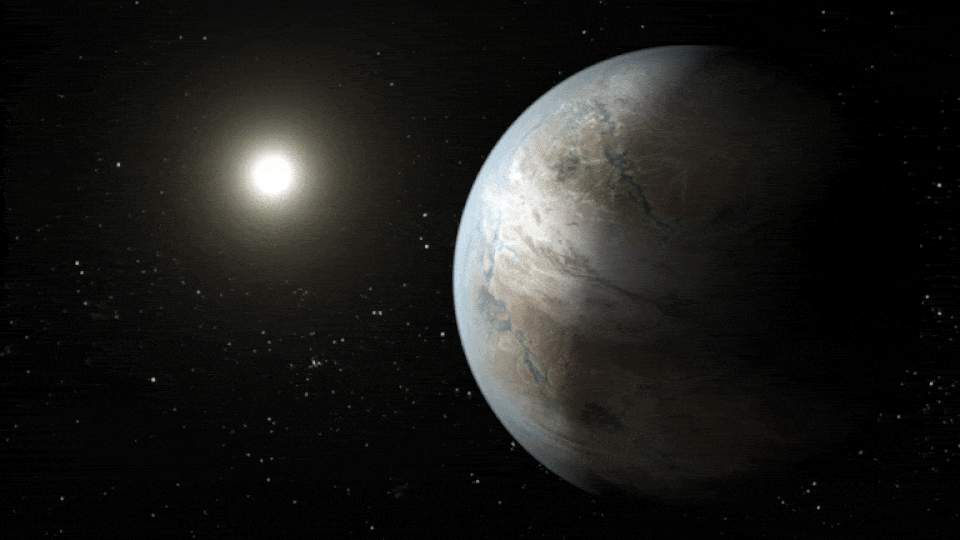
At present, scientists have three main ways to search for extraterrestrial life. The first is to launch orbiting probes, landing probes, Rovers and flying probes to planets that may have life in the solar system; The second is to further analyze the distant exoplanets we have found, hoping to find some biological characteristics, or at least some biological clues. The third is to look for technical features, such as unnatural signals created by intelligent civilization. In addition, some people are even looking for evidence that aliens have appeared on earth, but the scientific value of such research is controversial.
But what if we strongly suspect that there may not only be aliens in the universe, but even aliens similar to humans? Can we see them directly? So someone asked the question: "if we build a telescope large enough, can we see aliens walking around on other planets?"
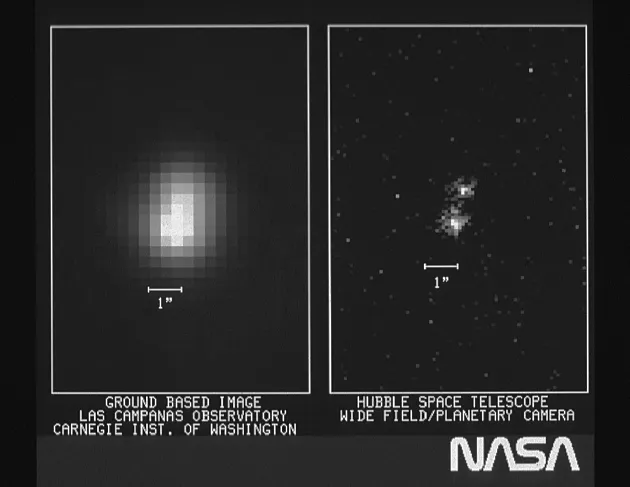
The picture shows the first picture taken by the then brand-new Hubble telescope in 1990. Without atmospheric interference and Hubble's large aperture, the resolution of its planetary system is much better than that of any ground-based telescope. The resolution mainly depends on the ratio of the light wavelength to the diameter of the main mirror.
Despite the obstacles, this vision is indeed possible. To this end, we must first solve the following problems.
First of all, for any optical system, the most important and basic point is resolution. If you want to see an object with a size of 1 meter, the resolution of the telescope should be 1 meter or even smaller. However, when using a telescope, we focus not on the actual size of the observation object, but on the angular size. This angular resolution means that only when the distance between the object and us is within a certain range, we can sensitively find objects of a specific size, but not objects outside this range.
You may have heard that the resolution of a telescope is determined by its own size, which is correct to some extent. The resolution of a telescope depends not only on the diameter of the primary mirror, but also on the wavelength of the light it observes. To put it more accurately, the resolution of a telescope is mainly determined by the ratio of the wavelength to the diameter of the main mirror. For example, with an aperture of 6.5 meters, the James Weber space telescope can observe light with a shortest wavelength of about 550 nm and a longest wavelength of 28000 nm. Therefore, the maximum resolution it can achieve is between 0.03 angular seconds of short wave and 1.4 angular seconds of long wave.
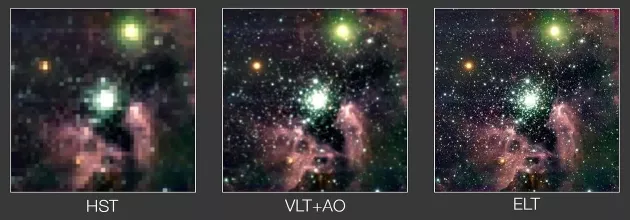
The objects simulated in these three images are NGC 3603, which are from the Hubble telescope (left), the very large telescope (middle) and the European great telescope under construction (left). The improvement of picture definition reflects the increase of telescope resolution.
Take the Hubble telescope, the most powerful telescope on the ground, as an example. With its position in space, can Hubble see humans on earth?
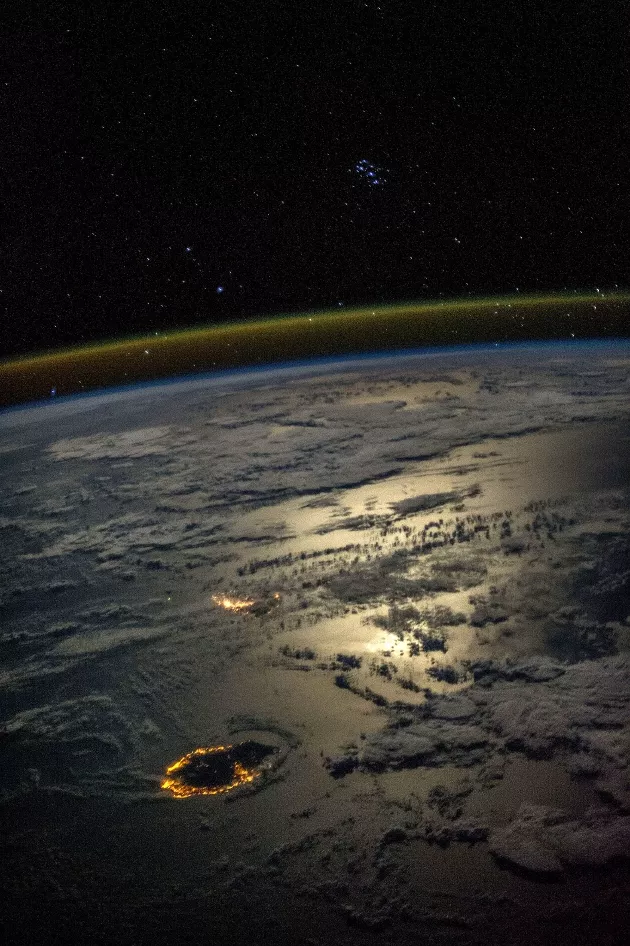
This photo was taken by astronaut Karen nieberg from the international space station in 2013. To see human beings on earth from the height of the international space station, you have to use a telescope as big as Hubble.
Please guess by intuition: Yes or no?
Well, let's reveal the answer. The main mirror of the Hubble telescope is 2.4 meters in diameter and is located about 547 kilometers above the earth's surface. Assuming that a person's size is about 1 meter (if you are upright when looking down from the top, this size will be smaller; but if you are lying on the ground, this size will be larger, so let's take an average), it is converted into an angular size, which is equivalent to 0.000105 °, or 0.37 angular seconds. Hubble can only achieve this resolution in the visible band, so if our color is blue, purple or ultraviolet, the answer is "visible"; But if our color is red, the answer is "not necessarily".
Using visible light to find human beings is more appropriate. It is more ideal if the planetary atmosphere is similar to the earth and the visible light penetration is strong. Short wave light has the advantage of greater resolution, but the planetary atmosphere is basically opaque to gamma and X-rays. Most ultraviolet light will also be blocked out. If there is a protective ozone layer, the blocking effect will be more obvious. Even if we send telescopes into space, we can search for humans with the help of such light with strong penetration in the earth's atmosphere.

This classic photo taken by Neil Armstrong shows Buzz Aldrin inserting an American flag on the surface of the moon. Notice the footprints in the foreground. These footprints are still clearly visible from lunar orbit, but the resolution of telescopes on earth is far from meeting the requirements.
To search for "humans" on an alien planet with the Hubble telescope (or other suitable instruments), we only need to find out how far away the observation object is from us, so we can know how large a telescope to build. The calculation is simple: if you want to observe objects 10 times farther than the upper limit of the Hubble telescope with the same resolution, you only need to make the diameter of the main mirror 10 times that of Hubble. Next, let's see how big telescopes need to be built to find aliens at different distances.
Moon
First let's take a look at our nearest neighbor, the earth's natural satellite - the moon. In terms of planetary distance, the moon is much closer to us than any celestial body in the solar system, even close enough for us to land on the lunar surface. The moon's orbit around the earth is elliptical rather than circular, so it is close and far from the earth. At perigee, the distance between earth and moon is 356500 km; 406700 km at apogee. From low earth orbit to the moon, the average propagation distance of light is about 380000 kilometers.
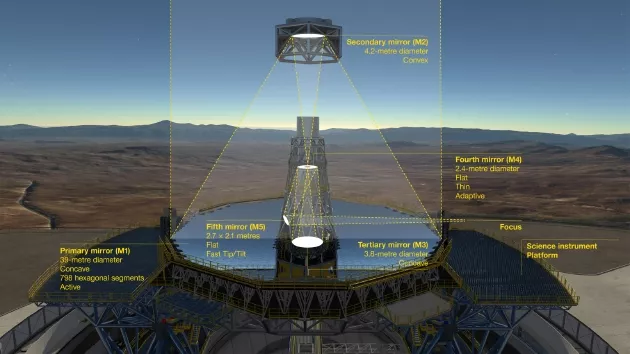
The picture shows the new five mirror optical system of the European maximum telescope. Before entering the scientific instrument inside the telescope, the light first passes through the concave main mirror (M1) with a diameter of 39 meters, and then reaches two lenses with a diameter of 4 meters, namely convex mirror (M2) and convex mirror (M3). The last two lenses (M4 and M5) form a built-in adaptive optics system, which can form a picture with high definition on the final focus plane. The main mirror consists of 798 lenses.
This means that if we want to observe the moon with the resolution of Hubble when observing the earth, the telescope aperture needs to reach 1650 meters. Building such a huge telescope is a feat, but it also costs a staggering price. The largest telescope built by mankind is the European giant telescope, with a diameter of 39 meters. It is still under construction in the southern hemisphere. The main mirror consists of 789 hexagonal lenses, each with a diameter of 1.4m. About 1.4 million such lenses are needed to build a 1600 meter telescope.
Venus and Mars
If we don't want to limit our sight to the moon and want to look for extraterrestrial life on other planets in the habitable belt of the solar system, it is Venus and Mars. Although the average distance between the two planets and the earth is more than 100 million kilometers, the distance between them and the earth is sometimes greatly shortened in the process of rotating around the sun. Venus can reach 38 million kilometers from the earth, while Mars is 62 million kilometers.
How to penetrate the thick clouds of Venus is a considerable challenge. Occasionally we can see the surface of Venus in visible light. Even so, it needs a crack in the cloud. Mars is much easier because its clouds and atmosphere are thin and penetrating. As long as there is no storm, the surface of Mars can be seen even from a long distance.
According to this distance, to see the "people" on the surface of Venus, the telescope aperture needs to reach 161 kilometers and that of Mars is 263 kilometers. The former is equivalent to the area of New Jersey, and the latter is equivalent to the whole of West Virginia.
Jupiter satellite
Perhaps one day, we will find life not only on rocky planets in the solar system, but also on a satellite of a gaseous giant planet. The nearest gas giant planet in the solar system is Jupiter. It is generally believed that Europa and Ganymede have characteristics suitable for life and survival. Compared with the distance to the earth, the distance from these satellites to Jupiter is almost negligible. When we were closest to the earth, Jupiter was "only" 588 million kilometers away from us.
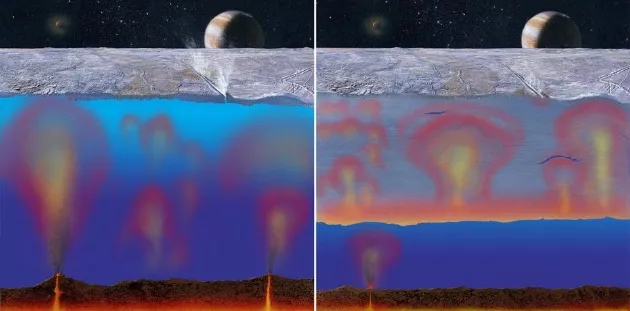
Scientists are almost certain that there is an underground ocean beneath Europa's icy surface, but it is not clear how thick the ice may be. The artist drew two cross-sections of Europa's ice shell. In both images, heat escapes from Europa's rocky mantle in the form of undersea volcanoes and is carried to the surface by ocean currents. A telescope the size of Alaska is needed to observe objects the size of humans on Europa's surface from earth.
In this way, the telescope we need has a diameter of 2500 kilometers and an area roughly equivalent to that of Alaska. Telescopes of this size are unimaginable because they are three-quarters the diameter of the moon. But the fact is that in order to take pictures of objects as large as humans from hundreds of millions of kilometers away, we need this kind of celestial scale telescope. As the situation becomes more serious, it will increase further.
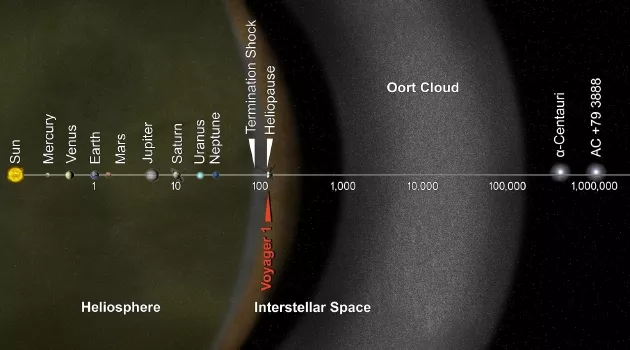
Through this scale, we can see how far away some celestial bodies are from us. The planets, the Kuiper belt, the Oort cloud, and the nearest stars are all on the map. To maintain the same resolution, the diameter of the main mirror should be increased by 10 times for every 10 times of the distance.
Saturn, Uranus, Neptune and beyond
The distance from Saturn to the earth is about twice that of Jupiter. When it is closest to the earth, it is 1.2 billion kilometers. The telescope aperture needs to reach 5000 kilometers, which is almost equivalent to Saturn's largest satellite and Titan, the second largest satellite in the solar system.
Uranus is twice as far away from the earth as Saturn. Even when it is closest, it is 2.57 billion kilometers. The telescope needs to have an aperture of 10800 kilometers, about 85% of the diameter of the earth.
When Neptune is closest to the earth, it is 4.298 billion kilometers, and the telescope aperture needs to reach 17800 kilometers, which is 1.5 times that of the earth.
As for the objects in the Kuiper belt, we have to build a telescope two or three times the diameter of the earth. To see the Oort cloud, the telescope aperture is almost the same as that of the sun. Not to mention planets orbiting other stars.
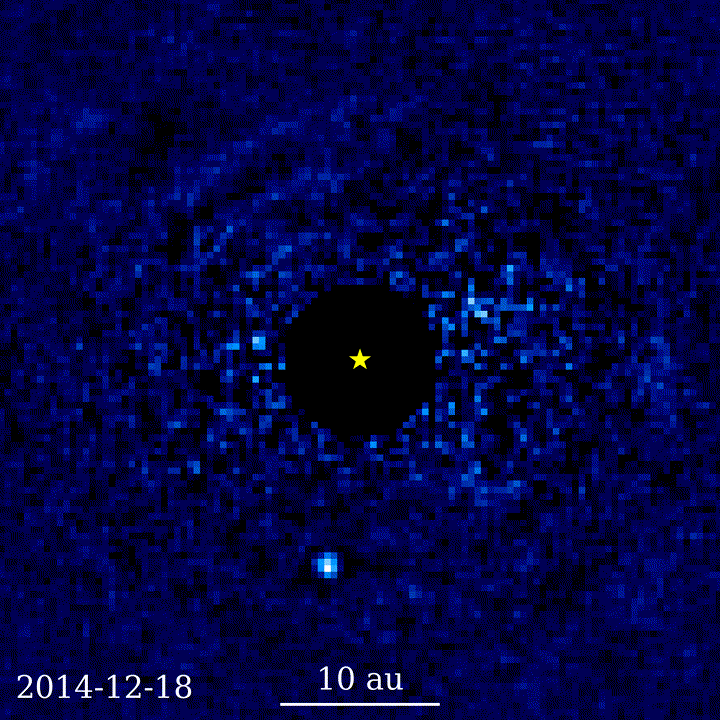
The constellation BOJIANG 51B was discovered by the Gemini planetary imager in 2014. Its mass is twice that of Jupiter. It is the lowest temperature and lowest mass exoplanet photographed at present. It is only 12 astronomical units away from the central star. To capture human sized objects on this planet, the resolution of the telescope needs to reach billions of times the current highest level.
Exoplanet
Unless we decide to send humans to other planets in the solar system, the probability of finding naturally evolved humans in these worlds is almost zero. But on planets outside the solar system, there may be creatures similar to humans.
Our distance to the nearest star is between 4 light-years and 10 light-years, and some of its planets may not only be livable, but may even have life forms the size of humans or larger.
How big a telescope is needed to see a 1m long object on a planet a few light-years away?
For the planets in our nearest neighbor galaxy, the telescope aperture needs to be equivalent to the earth's orbit. For the planets around tiancang 5, the diameter of the telescope should reach the diameter of the asteroid belt. To observe the planets in the TRAP-1 system, the telescope needs to be the size of Saturn's orbit. Do these sizes sound amazing? This is probably why no one has ever proposed to observe and search for extraterrestrial life directly through telescopes.
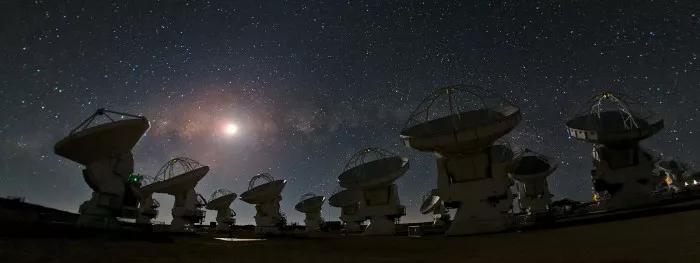
The Atacama large millimeter / submillimeter wave array consists of a series of radio telescopes. The focusing capacity of the array is equivalent to the sum of the telescopes, but the resolution takes into account the distance between the telescopes.
However, although the possibility is very small, it is still possible for us to find a technical solution. To build a huge telescope, there are two key points: first, it must be able to focus light, and the focusing ability must match the surface area; 2、 The resolution must be high enough to distinguish different objects, and the resolution must match the number of wavelengths that can be accommodated on the main mirror.
However, if the object we observe is bright enough, the focusing ability may not be so important, just ensure that the resolution is high enough.
For ultra long wave light, there is a technique called ultra long baseline interferometry, which can also be used in visible light band in theory. If we can build a network of small optical telescopes in the solar system, although its condensing capacity is only the sum of these telescopes, the resolution can also calculate the distance between these telescopes.
Although this is a great challenge, if we can manage to achieve it, our imaging detail will reach an unprecedented level. Although this is destined to be a long journey, it may be our greatest hope to know what alien life looks like.